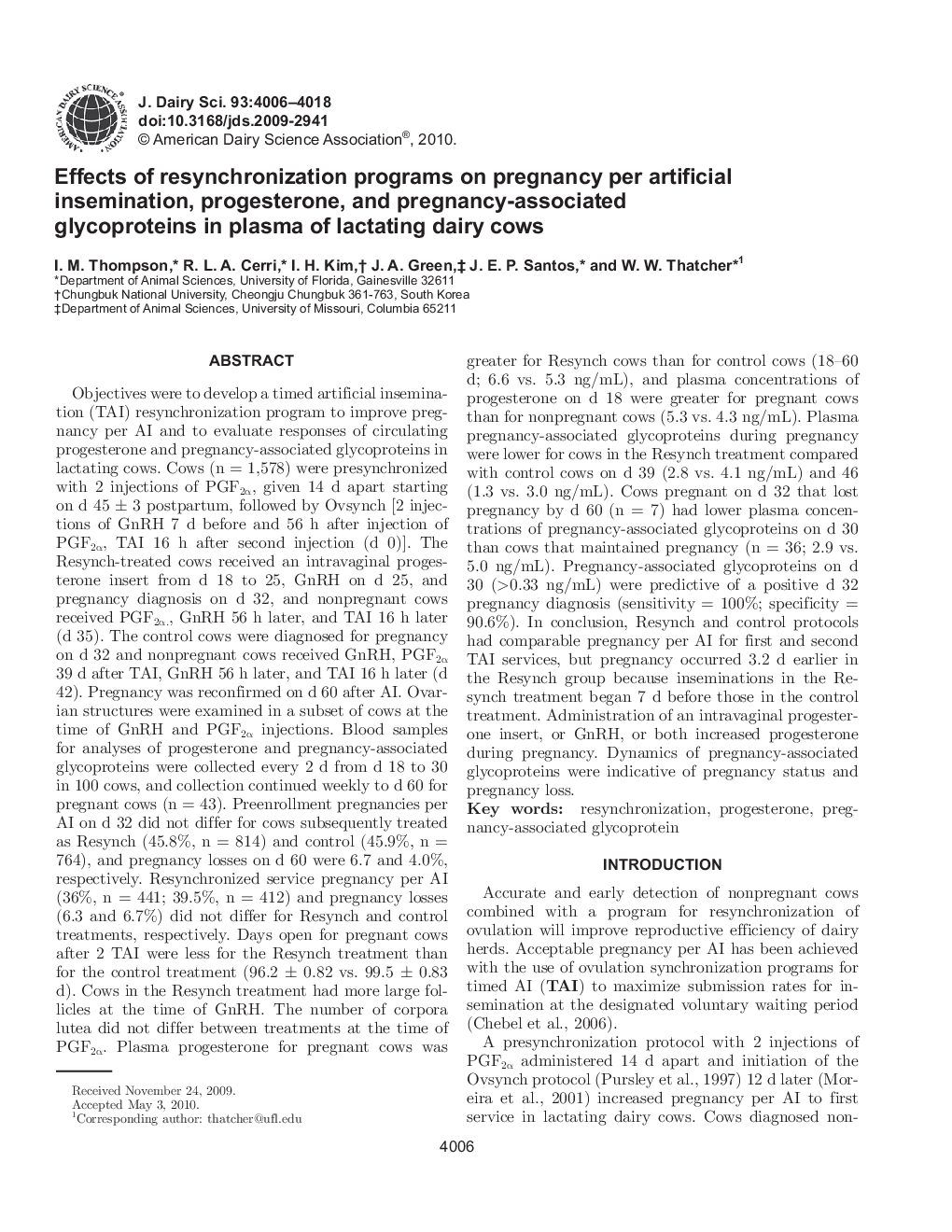| کد مقاله | کد نشریه | سال انتشار | مقاله انگلیسی | نسخه تمام متن |
|---|---|---|---|---|
| 10979752 | 1108066 | 2010 | 13 صفحه PDF | دانلود رایگان |
عنوان انگلیسی مقاله ISI
Effects of resynchronization programs on pregnancy per artificial insemination, progesterone, and pregnancy-associated glycoproteins in plasma of lactating dairy cows
دانلود مقاله + سفارش ترجمه
دانلود مقاله ISI انگلیسی
رایگان برای ایرانیان
کلمات کلیدی
موضوعات مرتبط
علوم زیستی و بیوفناوری
علوم کشاورزی و بیولوژیک
علوم دامی و جانورشناسی
پیش نمایش صفحه اول مقاله

چکیده انگلیسی
Objectives were to develop a timed artificial insemination (TAI) resynchronization program to improve pregnancy per AI and to evaluate responses of circulating progesterone and pregnancy-associated glycoproteins in lactating cows. Cows (n = 1,578) were presynchronized with 2 injections of PGF2α, given 14 d apart starting on d 45 ± 3 postpartum, followed by Ovsynch [2 injections of GnRH 7 d before and 56 h after injection of PGF2α, TAI 16 h after second injection (d 0)]. The Resynch-treated cows received an intravaginal progesterone insert from d 18 to 25, GnRH on d 25, and pregnancy diagnosis on d 32, and nonpregnant cows received PGF2α., GnRH 56 h later, and TAI 16 h later (d 35). The control cows were diagnosed for pregnancy on d 32 and nonpregnant cows received GnRH, PGF2α 39 d after TAI, GnRH 56 h later, and TAI 16 h later (d 42). Pregnancy was reconfirmed on d 60 after AI. Ovarian structures were examined in a subset of cows at the time of GnRH and PGF2α injections. Blood samples for analyses of progesterone and pregnancy-associated glycoproteins were collected every 2 d from d 18 to 30 in 100 cows, and collection continued weekly to d 60 for pregnant cows (n = 43). Preenrollment pregnancies per AI on d 32 did not differ for cows subsequently treated as Resynch (45.8%, n = 814) and control (45.9%, n = 764), and pregnancy losses on d 60 were 6.7 and 4.0%, respectively. Resynchronized service pregnancy per AI (36%, n = 441; 39.5%, n = 412) and pregnancy losses (6.3 and 6.7%) did not differ for Resynch and control treatments, respectively. Days open for pregnant cows after 2 TAI were less for the Resynch treatment than for the control treatment (96.2 ± 0.82 vs. 99.5 ± 0.83 d). Cows in the Resynch treatment had more large follicles at the time of GnRH. The number of corpora lutea did not differ between treatments at the time of PGF2α. Plasma progesterone for pregnant cows was greater for Resynch cows than for control cows (18-60 d; 6.6 vs. 5.3 ng/mL), and plasma concentrations of progesterone on d 18 were greater for pregnant cows than for nonpregnant cows (5.3 vs. 4.3 ng/mL). Plasma pregnancy-associated glycoproteins during pregnancy were lower for cows in the Resynch treatment compared with control cows on d 39 (2.8 vs. 4.1 ng/mL) and 46 (1.3 vs. 3.0 ng/mL). Cows pregnant on d 32 that lost pregnancy by d 60 (n = 7) had lower plasma concentrations of pregnancy-associated glycoproteins on d 30 than cows that maintained pregnancy (n = 36; 2.9 vs. 5.0 ng/mL). Pregnancy-associated glycoproteins on d 30 (>0.33 ng/mL) were predictive of a positive d 32 pregnancy diagnosis (sensitivity = 100%; specificity = 90.6%). In conclusion, Resynch and control protocols had comparable pregnancy per AI for first and second TAI services, but pregnancy occurred 3.2 d earlier in the Resynch group because inseminations in the Resynch treatment began 7 d before those in the control treatment. Administration of an intravaginal progesterone insert, or GnRH, or both increased progesterone during pregnancy. Dynamics of pregnancy-associated glycoproteins were indicative of pregnancy status and pregnancy loss.
ناشر
Database: Elsevier - ScienceDirect (ساینس دایرکت)
Journal: Journal of Dairy Science - Volume 93, Issue 9, September 2010, Pages 4006-4018
Journal: Journal of Dairy Science - Volume 93, Issue 9, September 2010, Pages 4006-4018
نویسندگان
I.M. Thompson, R.L.A. Cerri, I.H. Kim, J.A. Green, J.E.P. Santos, W.W. Thatcher,